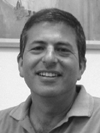|
DESCRIPTION
An accessible introduction to the relationship between Judaism and our individual responsibilities to care for the environment.
For everyone who wants to understand how Judaism views the natural world and the responsibilities of environmental stewardship, this book provides the way into an essential aspect of Judaism and allows you to interact directly with the sacred texts of the Jewish tradition.
At a time of growing concern about environmental issues, Jeremy Benstein, PhD—a founder and associate director of the Heschel Center for Environmental Learning and Leadership—explores the relationship Judaism has with the natural world and the ways in which Judaism contributes to contemporary social-environmental issues. He also shows us the extent to which Judaism is part of the problem and how it can be part of the solution.
Benstein offers both an environmental interpretation of Judaism and a Jewish approach to environmentalism, examining the dilemmas and questions we face when evaluating Judaism’s role in the care of creation:
- What environmentalism is. What do we mean by a “sustainable society”? What in our lives and our society needs to change in order to achieve it? How can we best apply Jewish ethics of caring for the land in all our lands and in the Land—the Land of Israel?
- What the Creation stories can teach us about who we are and what nature is. Are we essentially a part of the natural world—or crucially apart from it? Are we masters of creation—or its servants? Are we creatures or creators? What dreams and responsibilities flow from these roles?
- The relevance of Torah and traditional sources. What contemporary insights can be gleaned from ancient teachings? What role should the material world play in our spiritual lives? How can bringing Judaism and environmentalism into creative dialogue enrich our understanding of ourselves and our world, and contribute to tikkun olam, our repair of that world?
PRAISE FOR
“Only a guide as learned and as passionate as Jeremy Benstein could succeed so magnificently. Wise, deep, clear and healing, read it to root yourself in the soil of Torah, then heed its wisdom for the sake of our sweet, blue home.”
—Rabbi Bradley Shavit Artson, dean, Ziegler School of Rabbinic Studies; vice president, University of Judaism; author, Gift of Soul, Gift of Wisdom: A Spiritual Resource for Mentoring and Leadership
“Clear and thorough … brilliantly articulates a mandate of Jewish activism that is rooted in Jewish tradition and speaks to the broad range of issues we face in our twenty-first-century global village. Moves seamlessly between Jewish texts, theology and modern scientific thinking, at a level that a lay reader can easily follow…. A much needed resource to the field of Jewish environmentalism.”
—Rabbi Marla J. Feldman, director, Commission on Social Action of Reform Judaism
“Takes an engaging look at the interface between Jewish spirituality and the pressing concerns of environmentally conscientious Jews. Shows how traditional sources, viewed probingly, shed an edifying light on today’s concerns. Will attract newcomers to Jewish environmentalism and gratify old-hands.”
—Martin D. Yaffe, Center for Environmental Philosophy, University of North Texas
“Gives thoughtful consideration to the creative and careful attention needed to sustain us in the new millennium…. Maps the route toward the necessary healing of our planet and our people.”
—Rabbi Dan Ehrenkrantz, president, Reconstructionist Rabbinical College
“Rich in understanding of how wise Jewish thought addresses the relationship between adam and adamah—earth and ‘earthlings’—and how wise Jewish action can help to heal that relationship.”
—Rabbi Arthur Waskow, author of Torah of the Earth; Godwrestling—Round 2; and Down-to-Earth Judaism
“A beautiful and important entryway into a topic of vital importance. Offers both wisdom and hope. I commend it unhesitatingly to readers of all religious backgrounds or none.”
—Nigel Savage, founder and director of Hazon
| | | |
|
Reader Comments:
Submit a Comment
There was a lot of fascinating information in this book. I couldn’t wait to talk to someone about what I learned.
SUBMIT A COMMENT
|
JEREMY BENSTEIN BIO
Jeremy Benstein, PhD, a founder and associate director of the Heschel Center for Environmental Learning and Leadership, has published numerous articles on Judaism, Israel and environmentalism, including regular contributions to the Jerusalem Report. He holds a master’s degree in rabbinic literature and a doctorate in environmental anthropology, and frequently lectures on environmental ethics, consumer culture and religion, and the environment.
Q&A WITH JEREMY BENSTEIN
 Why a book about Jewish approaches to the environment? Aren’t most environmental issues scientific or technical, and so best left up to the experts? Even if it is our responsibility, when it comes to the environment aren’t we all in this together? Shouldn’t we set aside our differences and come together as humans to protect the Earth, our common home?
Why a book about Jewish approaches to the environment? Aren’t most environmental issues scientific or technical, and so best left up to the experts? Even if it is our responsibility, when it comes to the environment aren’t we all in this together? Shouldn’t we set aside our differences and come together as humans to protect the Earth, our common home?
Many environmental issues are indeed described in technical language, but science and technology only help us understand what are, essentially, the symptoms of the problems. The root causes lie in human behavior, and so are socio-political and psycho-spiritual in nature. They come from public policy and private lifestyle choices, which are value-driven. To understand the climate crisis, you need to know something about greenhouse gases; but it’s not a crisis of the climate, it’s a crisis among ourselves. To do something about the climate crisis, we need to change how we structure our economies and, ultimately, how we live our lives. This is not a matter for techno-experts, it’s for all of us.
It would be a mistake to think that there is a one-size-fits-all global solution for our problems, or that our deepest values dilemmas can be thrashed out separately from our faith commitments and personal and collective identities. Faith traditions in general, and Judaism in particular, have a lot to say about these problems; they are uniquely situated to impact the lives of many people. Since so many of the issues derive from twentieth-century trends of industrialization, globalization, and consumer lifestyles, age-old teachings with a spiritual vision of the good life can help us critique and change our own lives for the betterment of all.
Repairing the world (tikkun olam) is a central Jewish value (as ably explored by Elliot Dorff in his book in The Way Into … Series)—it’s time to put the olam (world) back in tikkun olam.
But, come on, Torah and toxic waste? Jewish values and global warming?
For those who have never studied it, the Talmud and Jewish law and lore (Halacha and Aggada) deal with that and a lot more. The order of damages or tort law (nezikin) has many rulings regarding damages or health-impairment inflicted on others via the environment, including pollution and even toxic waste.
A major set of teachings deals with how we should behave regarding the commons (reshut harabim)—all those parts of the world that are not private property but that we all enjoy—from roads, sidewalks, and parks to rivers, the oceans, and the atmosphere itself. So, yes, while global warming and the climate crisis are new problems, the underlying behaviors that have led to them are not, and so global warming is a focus of Jewish legal regulation.
When I think of “environment” I think of wilderness and air and water pollution, garbage, and, now, climate change. But you include many other issues as well. What is “environmentalism” for you?
“Environmentalism” is a vision of how to make the world a better place for all its inhabitants, now and for future generations. It is not a litany of doomsday predictions or a call to return to pre-modern or impoverished lifestyles. There used to be a clear divide between environmental and social issues, but we are now realizing that the growing gap between rich and poor is both a social and an environmental ill, and that justice needs to be applied not only in allocation of funds and social opportunities but also in exposure to risk and access to environmental goods. Additionally, in so many ways the personal has become very political: All our consumer choices help shape the world, for better or for worse, and so everything needs to be included in a holistic vision.
DISCUSSION QUESTIONS
Download a printable version
- Prof. Steven Schwartzschild claims Jews are “unnatural persons” (p. 26). Do you agree or disagree, and why? How have the ways we have conceptualized Jewish identity and practiced our Judaism been alienated from nature and the environment, and what can we do to change that?
- Do the Creation stories discussed in chapter 2 still shape our worldviews today? In what ways are these ancient “unscientific” texts relevant to contemporary challenges? How do you see the human role in the world: Crowning glory of Creation? Plain citizen in the community of life? Captain of spaceship Earth? Global gardener?
- The beginning of chapter 3 deals with the challenges in connecting the spiritual and the material sides of our lives. What personal issues have you faced in this area? What aspects of our lives make this difficult?
- Some of the topics of chapter 4 (consumerism, protecting the commons, land use policy) suggest a critique of an unregulated free-market economy, and contemporary consumer lifestyle. In what ways do you agree or disagree with this critique? How, if at all, can we affect these aspects of our lives and societies? What would you like to do in this regard?
- There are many deep ethical dilemmas in the ways we treat animals, from the way we raise animals for food, to the extent we experiment on them to improve human welfare (pp. 101–107; pp. 149–159). Where should we draw the line between legitimate use and abuse?
- Chapter 5 talks about holidays, Shabbat, and prayer. What could change in our communal and personal observances and celebrations to make them more environmentally friendly? What can you do in your community and synagogue to promote Jewish environmental consciousness in your practices?
- In what ways does the idea of a Jewish sense of place resonate with you? What risks of assimilation do we face by “feeling at home” in the various environments of the Diaspora? How, if it all, is a deep connection to place, and to Israel as the Jewish place, obsolete or dangerous?
CONTACT THE AUTHOR
PURCHASE BELOW
|
The Way Into Judaism and the Environment
|

